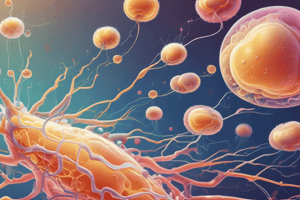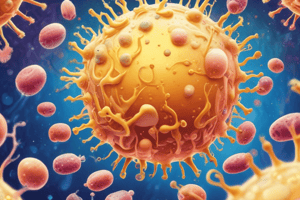Podcast
Questions and Answers
What is the primary purpose of the slide coagulase test?
What is the primary purpose of the slide coagulase test?
- To detect bound coagulase in Staphylococcus species (correct)
- To identify the species of Streptococcus
- To differentiate S.aureus from coagulase negative staphylococci
- To detect the presence of free coagulase
What should be done if the slide coagulase test result is negative?
What should be done if the slide coagulase test result is negative?
- Proceed to tube coagulase testing (correct)
- Perform the Novobiocin Susceptibility Test
- Conduct a Gram stain for further identification
- Re-test with a different bacterial colony
What is one advantage of the slide coagulase test?
What is one advantage of the slide coagulase test?
- It is a rapid diagnostic method (correct)
- It provides a definitive identification of S.aureus
- It can differentiate all species of staphylococci
- It is more accurate than tube coagulase testing
What is the incubation temperature for the tube coagulase test?
What is the incubation temperature for the tube coagulase test?
Which of the following is a disadvantage of the slide coagulase test?
Which of the following is a disadvantage of the slide coagulase test?
What is transferred into the tube during the tube coagulase test?
What is transferred into the tube during the tube coagulase test?
What is the arrangement of Staphylococcus spp. cells?
What is the arrangement of Staphylococcus spp. cells?
Which characteristic is NOT associated with Staphylococcus spp.?
Which characteristic is NOT associated with Staphylococcus spp.?
What kind of infections can Staphylococcus aureus cause?
What kind of infections can Staphylococcus aureus cause?
What is a defining feature of Staphylococcus spp. regarding temperature resistance?
What is a defining feature of Staphylococcus spp. regarding temperature resistance?
Which term describes the presence of Staphylococcus aureus on the skin?
Which term describes the presence of Staphylococcus aureus on the skin?
What is the typical appearance of non-bullous impetigo caused by Staphylococcus aureus?
What is the typical appearance of non-bullous impetigo caused by Staphylococcus aureus?
Which species is commonly associated with folliculitis?
Which species is commonly associated with folliculitis?
Which environment can Staphylococcus spp. tolerate?
Which environment can Staphylococcus spp. tolerate?
What is the typical cause of bullous impetigo?
What is the typical cause of bullous impetigo?
What type of infection is primarily caused by Staphylococcus aureus?
What type of infection is primarily caused by Staphylococcus aureus?
Which Staphylococcus species is most commonly associated with catheter-related bloodstream infections?
Which Staphylococcus species is most commonly associated with catheter-related bloodstream infections?
What characterizes a furuncle?
What characterizes a furuncle?
What is a defining feature of a carbuncle?
What is a defining feature of a carbuncle?
What type of colony does Staphylococcus species form on culture?
What type of colony does Staphylococcus species form on culture?
Which Staphylococcus species is a part of the normal flora in women and often causes UTIs?
Which Staphylococcus species is a part of the normal flora in women and often causes UTIs?
At what temperature do Staphylococcus species grow fastest?
At what temperature do Staphylococcus species grow fastest?
Which of the following is a superficial infection of the skin that is often caused by Staphylococcus aureus?
Which of the following is a superficial infection of the skin that is often caused by Staphylococcus aureus?
Which Staphylococcus species is most commonly associated with acute osteomyelitis?
Which Staphylococcus species is most commonly associated with acute osteomyelitis?
What type of formation surrounds pus in an abscess?
What type of formation surrounds pus in an abscess?
What is the principle behind the catalase test?
What is the principle behind the catalase test?
Which of the following organisms is catalase positive?
Which of the following organisms is catalase positive?
What indicates a positive catalase test result?
What indicates a positive catalase test result?
What type of coagulase is detected by the slide coagulase test?
What type of coagulase is detected by the slide coagulase test?
What is required to form staphylothrombin in the presence of free coagulase?
What is required to form staphylothrombin in the presence of free coagulase?
What happens during the catalase test when hydrogen peroxide is added?
What happens during the catalase test when hydrogen peroxide is added?
What differentiates staphylococci from streptococci in testing?
What differentiates staphylococci from streptococci in testing?
Which type of test detects free coagulase?
Which type of test detects free coagulase?
What is a key characteristic of coagulase-negative staphylococci (CoNS)?
What is a key characteristic of coagulase-negative staphylococci (CoNS)?
What does cell wall bound coagulase react with during the slide coagulase test?
What does cell wall bound coagulase react with during the slide coagulase test?
What is the pigment produced by Staphylococcus aureus that contributes to its golden yellow colonies?
What is the pigment produced by Staphylococcus aureus that contributes to its golden yellow colonies?
What is the primary reason Staphylococcus aureus turns mannitol salt agar from red to yellow?
What is the primary reason Staphylococcus aureus turns mannitol salt agar from red to yellow?
Which type of agar allows the differentiation of Staphylococcus aureus based on DNAse production?
Which type of agar allows the differentiation of Staphylococcus aureus based on DNAse production?
What is a characteristic feature of Staphylococcus aureus colonies on blood agar?
What is a characteristic feature of Staphylococcus aureus colonies on blood agar?
Which virulence factor of Staphylococcus aureus protects it from phagocytosis by forming a fibrin clot?
Which virulence factor of Staphylococcus aureus protects it from phagocytosis by forming a fibrin clot?
What property of Staphylococcus aureus distinguishes it from Staphylococcus epidermidis on DNAse agar?
What property of Staphylococcus aureus distinguishes it from Staphylococcus epidermidis on DNAse agar?
Which statement accurately describes cellulitis caused by Staphylococcus aureus?
Which statement accurately describes cellulitis caused by Staphylococcus aureus?
What is one of the biochemical tests that Staphylococcus aureus is positive for?
What is one of the biochemical tests that Staphylococcus aureus is positive for?
What color indicates a positive result for the fermentation of mannitol on mannitol salt agar?
What color indicates a positive result for the fermentation of mannitol on mannitol salt agar?
Study Notes
Staphylococcus Species
- Staphylococcus are gram-positive bacteria arranged in grape-like clusters. They are non-motile, non-spore forming and ferment carbohydrates to produce lactic acid.
- Staphylococcus species are relatively resistant to drying and heat, able to withstand 50°C for 30 minutes.
- These bacteria are halo tolerant and can live in environments with up to 9% NaCl.
- Some Staphylococcus are normal flora of the skin and mucous membranes.
- Staphylococcus aureus is found on the skin, in the nostrils, and armpits.
- Staphylococcus species can cause suppurative (pus-forming) infections and septicemia.
Common Suppurative Infections caused by Staphylococci
- Folliculitis: Superficial infection involving the hair follicle.
- Furuncle/Boil: Deeper than folliculitis, more extensive, and more painful, but centers around the hair follicle.
- Abscess: Have a wall formation around the pus.
- Carbuncle: Accumulation of boils/furuncles.
- Erysipelas: Superficial layer of the skin is affected. There is a layer that is "pushed up".
- Cellulitis: Deeper layer of the skin is affected. No pushing up of the skin. Margin of the involved area is less distinct.
Clinically Important Staphylococcus Species
- Staphylococcus aureus: Causes pyogenic skin and soft tissue infections, pneumonia, bacteremia, infective endocarditis, and toxin-mediated illnesses.
- Staphylococcus epidermidis: Infections from skin contamination and implants/prosthetic materials (CRBSI, prosthetic and native valve endocarditis).
- Staphylococcus lugdunensis: Infection from skin contamination and implants, native valve endocarditis, and osteomyelitis.
- Staphylococcus saprophyticus: Urinary tract infections (UTIs) in young women. Part of the normal flora in women.
Staphylococcus Species on Culture
- Staphylococcus species grow fastest at 37°C but produce pigment best at room temperature (20-25°C).
- They form round, raised, smooth, shiny colonies.
- Staphylococcus lugdunensis, Staphylococcus epidermidis, and Staphylococcus saprophyticus produce cream to whitish-grey colonies.
- Staphylococcus aureus can produce golden yellow colored colonies due to a pigment known as staphyloxanthin.
Staphylococcus aureus on Culture
- Staphylococcus aureus can produce cream or golden yellow colonies on nutrient agar.
- Staphylococcus aureus turns red agar to yellow due to the fermentation of mannitol on mannitol salt agar.
- Staphylococcus aureus produces a halo of clear beta-hemolysis on blood agar plates.
- Staphylococcus aureus is the only species possessing DNAse, which can be observed on DNAse agar.
Staphylococcus aureus Virulence Factors
- Catalase: Protects intraphagocytic microbes by destroying hydrogen peroxide produced by the phagocyte.
- Coagulase: Formation of fibrin clot around the bacteria likely protects it from phagocytosis and can function as a biofilm scaffold.
- Hyaluronidase: Spreading factor; allows dissemination of bacteria through tissue.
Catalase Testing Differentiates Staphylococci and Streptococci
-
All staphylococcal species give a positive catalase test, which differentiates them from streptococci.
-
The production of water and oxygen from hydrogen peroxide through the enzyme catalase is the principle behind the test.
-
A positive result is observed as bubbling or effervescence due to the release of oxygen from hydrogen peroxide.
Coagulase Testing Differentiates Staphylococcus aureus from Coagulase-Negative Staphylococci
- Coagulase is an enzyme-like protein that causes plasma to clot by converting fibrinogen to fibrin.
- Staphylococcus aureus produces two types of coagulase: bound coagulase and free coagulase.
- Bound Coagulase: Cell wall-bound coagulase, also known as clumping factor, is detected by the slide coagulase test.
- Free Coagulase: Detected by the tube coagulase test. Requires the presence of a coagulase-reacting factor (CRF) to form staphylothrombin, which reacts with fibrinogen to form a fibrin clot.
Slide and Tube Coagulase Testing
-
Slide Coagulase Test: Detects bound coagulase.
- Add one drop of heavy bacterial suspension and one drop of plasma to a clean slide.
- Mix well and observe for clumping, clotting, agglutination, or coagulation after ten seconds.
- Advantages: Rapid diagnosis.
- Disadvantages: Less accurate.
-
Tube Coagulase Test: Detects free coagulase.
- Transfer 0.5 mL of reconstituted plasma into the test tube.
- Select 2-3 isolated colonies of bacteria to be tested.
- Emulsify the bacteria in the plasma and place the tubes in the incubator at 37°C.
- Note the time the test was started.
Studying That Suits You
Use AI to generate personalized quizzes and flashcards to suit your learning preferences.
Related Documents
Description
This quiz explores Staphylococcus species and their characteristics, including their structure and resistance. It also covers common suppurative infections caused by these bacteria, such as folliculitis, boils, and abscesses. Test your knowledge on this important topic in microbiology and infectious diseases.





